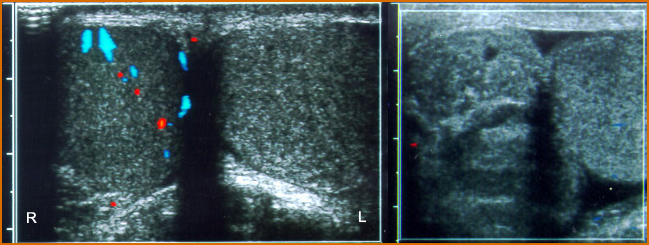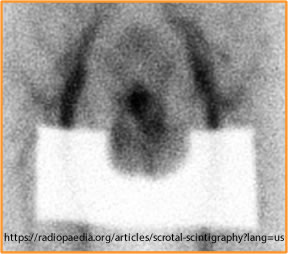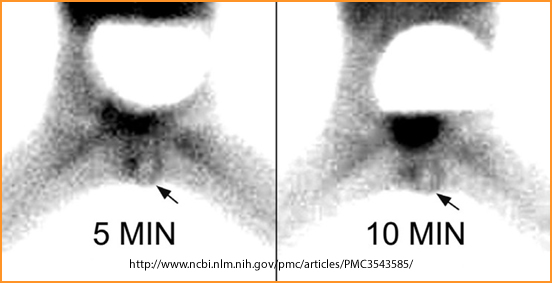- Tunica vaginalis covers the testis and the anterior portion of the epididymis, while the posterior portion of the epididymis attaches to the scrotal wall via connective tissue. This prevents prevents torsion
- Torsion occurs when the testis/epididymis are not attached to the scrotal wall. Twisting causes loss of blood supply to the testicles resulting in testicular torsion. Should the testes untwist the initial loss of vascular supply cause edema and congestion within the region, this can lead to and cause hemorrhage and infarct
- End result is a loss of blood supply and death to the testis or testes
- Torsion can also result when the tunica vaginalis completely envelops the testes, epididymis, and distal spermatic cord. The distal spermatic cord, testes, and epididymis are then freely suspended within two layers of tunica vaginalis and this is known as the "bell clapper deformity"
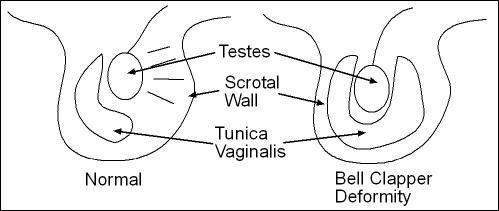
- One in 4000 males are at risk
- Peaks at 14 years of age and may occur up to age 30. Beyond 30 years of age is rare
- Frequently occurs during sleep
- May be relate to high testosterone levels or relaxation
- Symptoms - Acute onset of pain, but may resolve itself, low grade fever, nausea and vomiting, no urinary problems
- Testicles are swollen and tender
- Occurs in adult, unusual above the age of 14
- There are four types
- Nonspecific Epididymitis - most common and may occur with urine infection
- Specific Epididymitis - caused by gonorrhea or 2nd stage syphilis
- Traumatic Epididymitis - caused by trauma or trauma may activate the infection
- Mumps orchitis - older boys or men and occurs with mumps
- Examination of epididymitis reveals tender enlargement, fever, and prostatic tenderness
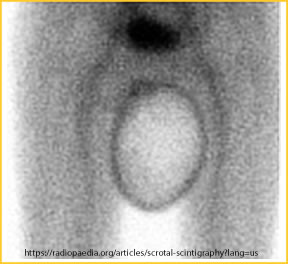
- This can sometimes be mistaken as torsion since an area lacking uptake is seen
- It differs from torsion, it lacks a hyperemic rim
- The area in question contains fluid resulting in photopenic area

http://pubs.rsna.org/doi/pdf/10.1148/radiology.137.1.7422850
- Usually occurs on the left side (99%). Usually found in men that are infertile
- Procedure
- Radiolabeled RBCs are injected and the effected side usually has blood pooling (activity) in the effected hemiscrotum
- Val salva is suggested when imaging. This approach will enhance blood pooling in the effected area

- Tap the penis to the abdomen
- Use a sling or towel to support/prop up the testicles so that they are parallel to the camera
- Inject 15 to 20 mCi 99mTcO4-
- Take a 3 to 10 second dynamic for approximately 60 seconds
- Take 300-500k delayed images for an additional 10 to 15 minutes
- Image magification may also be applied
- Optional - Consider using a thin Pb marker and place it between the testicles and take one last image (helps in differentiating between the right and left testicle)
- Further delayed images may be considered but are usullay not required
- What does a normal scan look like?
- The above images are an example of Epididymitis. Notice that the affected side has increased uptake of the radiopharmaceutical
- The above images are an example of Torsion. Notice how the affected testicle al lacks radionuclidic uptake and the hyperemic rim
- So what do you think is going on with these imagings - hint it is a false positive if you thinik its torsion
- What does Ultrasound see?
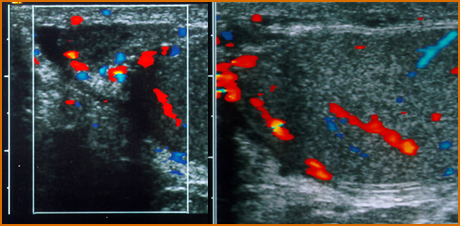
- On the left is normal blood flow with transverse color Doppler seen throughout the testicle. The image on the right is normal blood flow in the longitudinal Transverse color Doppler of testis and epididymis
- In our next examples show torsion: The image on the left shows both testes with absence of flow or color on the left testicle, but blood flow is seen on the right. The image on the right shows absolutely no color Doppler indicating no flow
